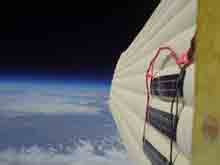A prototype inflatable-wing aircraft will be flight tested at 100,000ft (30,500m) over Colorado next month as part of a NASA-funded joint project between the University of Kentucky and Oklahoma State University (OSU) to develop technology for a possible Mars probe. The 2.1m-long aircraft weighs about 6.8kg (15lb) and has an inflated wingspan of about 2.1m.
In March a weather balloon will carry the unmanned prototype to 100,000ft, during which time the wing inflates. At the target altitude it is dropped, deploying a parachute initially and then being released to begin free flight.
© Jamey Jacob | ||||
|---|---|---|---|---|
The sequence (clockwise from top left) as the inflatable wing was tested |
If the first flight is successful, a second launch at 110,000ft will take place in the third quarter.
"To simulate the atmosphere on Mars, the aircraft must be launched at 100,000ft above sea level," says OSU associate professor of mechanical and aerospace engineering Jamey Jacob.
Jacob's team previously tested a wing design using resins that cure in ultraviolet light. On a Mars mission, the aircraft would be deployed by an entry vehicle and, once its wing inflates, the UV-sensitive resin would cure, ensuring inflation pressure was not needed to maintain its shape.
The aircraft is also being proposed as a backpack-carried UAV for soldiers and emergency workers, with the wing deflated for storage and inflated for use.
Oklahoma's students are designing the aircraft's exterior while the Kentucky team is integrating the internal systems.
Source: Flight International



























